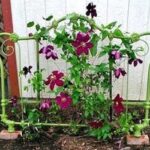Are you looking for free garden designs and layouts to transform your outdoor space? A well-designed garden not only enhances the beauty of your home but also provides a relaxing and functional environment for outdoor activities. In this article, we will explore the importance of garden designs and layouts, along with tips and resources to help you create your own personalized garden oasis.
Having a well-thought-out garden design can significantly enhance the overall appeal of your property. It allows you to create a harmonious outdoor space that reflects your style and personality while also providing practical features for relaxation and entertainment. Additionally, a functional layout ensures that every corner of your garden is utilized efficiently, maximizing its potential as a living space.
Before diving into specific design ideas and resources, it’s crucial to assess your garden space and identify your needs and goals for the area. Evaluating available space, sunlight exposure, soil conditions, and any existing elements will help determine the best approach to designing and arranging your garden. Understanding the unique characteristics of your outdoor space will allow you to create a layout that complements both the natural environment and your desired activities in the garden.
Getting Started
When it comes to creating a well-designed garden, one of the first steps is to assess your available garden space and identify your specific needs and goals. Here are some helpful tips for getting started:
- Evaluate the available space for the garden: Measure the dimensions of your garden space, taking note of any existing features such as trees, slopes, or structures that may impact your design. Consider factors such as sunlight exposure and soil quality to determine which areas are most suitable for different types of plants.
- Identify the specific needs and goals for the garden design and layout: Think about how you intend to use your garden – whether it’s for relaxing, entertaining, growing food, or simply enhancing your outdoor environment. Consider any specific requirements such as child-friendly areas, pet spaces, or accessibility needs. By understanding your needs and goals, you can create a garden design that truly reflects your lifestyle and preferences.
By carefully assessing your garden space and identifying your specific needs, you can lay a solid foundation for creating a personalized and functional garden design. Whether you have a small urban plot or a spacious backyard, understanding your space and needs will help you make informed decisions when it comes to designing a beautiful outdoor environment.
Free Garden Design Tools and Resources
When it comes to designing a garden, having access to the right tools and resources can make a significant difference. Fortunately, there are plenty of free software and online resources available to assist both novice and experienced gardeners in creating their ideal garden layout.
One popular option is the virtual garden visualizer from Better Homes & Gardens, which allows users to plan and design their outdoor space with 3D models of plants, hardscape, and more. Additionally, the Garden Planner from The Old Farmer’s Almanac is another helpful tool for creating customized garden designs, complete with a planting schedule for optimal growth.
In addition to these free software options, there are numerous online resources offering valuable tips and inspiration for garden design. Websites such as Houzz and Pinterest provide a wealth of garden design ideas, along with user-friendly interfaces that make it easy to save and organize your favorite designs. These platforms also allow users to connect with other gardening enthusiasts, sharing valuable insights and recommendations for creating stunning and functional outdoor spaces.
As you explore these free garden design tools and resources, keep in mind that personalization is key. While these tools offer pre-designed elements and templates, don’t be afraid to experiment with different layouts and features that align with your specific vision for your garden. By taking advantage of these resources while infusing your creativity and personal style into the design process, you can achieve a truly unique and beautiful outdoor space.
| Free Garden Design Tools | Resources |
|---|---|
| Better Homes & Gardens Virtual Garden Visualizer | Allows users to plan their outdoor space using 3D models of plants, hardscape, etc. |
| The Old Farmer’s Almanac Garden Planner | Creates customized garden designs complete with a planting schedule |
| Houzz | Provides a wide array of garden design ideas along with user-friendly interface |
| Offers a platform for saving & organizing favorite designs & connecting with other gardening enthusiasts. |
Designing Your Garden
When it comes to designing your garden, it’s important to consider the various elements and features that will make up the space. This includes everything from the types of plants you want to incorporate, to hardscape elements like pathways and outdoor furniture. One key aspect of this process is to plan out how these different elements will work together to create a cohesive, beautiful design that suits your personal style and needs.
One of the first steps in incorporating elements into your garden design is to make a list of the specific features you want to include. This could be anything from a specific type of flower or shrub, to a seating area or water feature. By identifying these key elements early on, you can ensure that they are seamlessly integrated into your overall design plan.
In addition to plants and hardscape, it’s also important to consider functional elements such as lighting and irrigation. These components not only contribute to the aesthetic appeal of your garden but also play a crucial role in its overall functionality. By carefully considering all these different elements and features, you can create a well-rounded garden design that is both visually stunning and practical for everyday use.
| Aspect | Considerations |
|---|---|
| Plants | List specific types you want to include; consider seasonal variations |
| Hardscape | Incorporate pathways, seating areas, water features |
| Functional Elements | Lighting, irrigation for both aesthetic appeal and functionality |
Layout Considerations
When it comes to creating a well-designed garden, considering the layout is crucial for ensuring functionality and flow within the space. A carefully planned layout can make it easier to navigate through the garden and access different areas, ultimately enhancing the overall experience of the outdoor space.
Discussing Practical Layout
A practical layout takes into account the different activities and functions that will take place in the garden. Whether it’s a designated area for outdoor dining, a play area for children, or space for gardening activities, each function should be carefully considered when planning the layout. By having a clear understanding of how the garden will be used, it becomes easier to allocate space and create a layout that serves those purposes effectively.
Tips for Creating Functional Flow
In addition to planning for specific functions, creating functional flow within the garden is essential for maximizing usability. This involves designing paths and walkways that provide easy access to various parts of the garden while maintaining a harmonious connection between different areas. Strategic placement of elements such as plant beds, seating areas, and decorative features can contribute to a smooth flow that makes the garden feel inviting and well-organized.
Importance of Accessibility and Safety
Another important aspect of layout considerations is ensuring accessibility and safety within the garden. This includes making sure that pathways are wide enough for comfortable movement, especially for individuals with mobility challenges. Implementing proper lighting along pathways can also enhance safety, allowing for nighttime enjoyment of the garden while reducing potential hazards. By prioritizing accessibility and safety in the layout design, you can create a welcoming environment that can be enjoyed by everyone.
Maximizing Small Spaces
When it comes to creating a stunning garden design in a limited space, creativity and strategic planning are essential. With the right approach, even the smallest of gardens can be transformed into beautiful and functional outdoor spaces. Here are some tips for making the most of limited garden space:
- Vertical gardening: Utilize vertical space by incorporating hanging planters, trellises, and wall-mounted containers. This allows you to maximize the growing area without taking up valuable ground space.
- Multi-functional furniture: Choose outdoor furniture that serves multiple purposes, such as storage benches or foldable tables and chairs. This helps to optimize space while providing seating and storage options.
- Strategic plant selection: Opt for compact or dwarf varieties of plants and flowers that won’t overpower the small space. Consider incorporating a mix of perennials, annuals, and ornamental grasses to add variety without overcrowding the garden.
In addition to these tips, consider exploring creative solutions such as tiered planters, raised beds, and container gardening to make the most of limited garden space. By thinking outside the box and strategically planning your layout, you can create a stunning garden design that makes the most of every inch.
Maintaining and Upkeep
Once you have put time and effort into designing your garden, it’s important to ensure that it stays looking great all year round. Regular maintenance is essential to preserve the beauty of your garden design. One key aspect of upkeep is ensuring that your plants are well-cared for.
This includes regular watering, pruning, and fertilizing as needed. It’s also important to keep an eye out for any signs of pests or diseases in order to address them promptly and prevent them from spreading.
In addition to plant care, maintaining the hardscape elements of your garden is crucial. This involves periodic cleaning and repairs as necessary. For example, pathways and patios may need to be swept or power washed to remove debris or stains, while fences or trellises may require repainting or re-staining to maintain their appearance and protect them from the elements.
Seasonal changes and weather conditions can also impact the look of your garden design. It’s important to adapt your maintenance routine based on these factors. For example, during the fall season, it’s crucial to remove fallen leaves and prepare the garden for winter.
In the spring, cleaning up after winter weather and preparing the garden for new growth becomes a priority. Adapting your maintenance strategies to fit the changing seasons will help keep your garden looking its best throughout the year. By staying consistent with maintenance tasks, you can ensure that your well-designed garden continues to provide enjoyment and beauty for years to come.
Conclusion
In conclusion, creating a well-designed garden layout can bring numerous benefits to both the functionality and aesthetics of your outdoor space. By carefully assessing your available space and specific needs, you can use free garden design tools and resources to personalize your garden layout. Incorporating elements such as plants, hardscape, and outdoor furniture can help create a cohesive and beautiful design that suits your personal style and needs.
Additionally, considering the importance of functionality and flow in the layout of your garden can promote easy movement and access to different areas within the space. This is especially crucial when maximizing small spaces, where creative solutions can help make the most out of limited garden areas. Finally, maintaining and upkeep are essential for preserving the beauty of your garden design throughout changing seasons and weather conditions.
Ultimately, embracing the beauty and benefits of a well-designed garden involves implementing the tips and ideas discussed in this article. From utilizing free design tools to incorporating practical layout considerations, creating a stunning garden design that suits your specific needs is within reach. With regular maintenance and adaptation to changing conditions, you can ensure that your well-designed garden continues to thrive year-round.
Frequently Asked Questions
Is There a Free App for Landscape Design?
Yes, there are several free apps available for landscape design. These apps often offer features like 3D modeling, plant libraries, and the ability to input specific dimensions for your outdoor space. Some popular free landscape design apps include Home Outside, iScape, and RoomSketcher.
How Do You Layout a Garden for Beginners?
For beginners looking to layout a garden, it’s important to start by considering factors such as sunlight exposure, soil type, and drainage. Researching the plants that will thrive in your specific conditions is crucial. Additionally, sketching out a simple plan for the garden layout can help visualize where each plant will go before actually planting anything in the ground.
What Is the Most Efficient Garden Layout?
The most efficient garden layout often depends on the specific goals of the gardener. However, the square foot gardening method has gained popularity for its efficiency in maximizing space and reducing water usage.
This method involves dividing the garden into square foot sections for planting different crops based on their spacing requirements. Raised beds a also often used to maximize growing area and make maintenance easier.

Welcome to my gardening blog! I am passionate about plants and enjoy sharing my knowledge and experiences with others. In this blog, I will write about everything related to gardening, from tips on how to get started to updates on my own garden projects.





